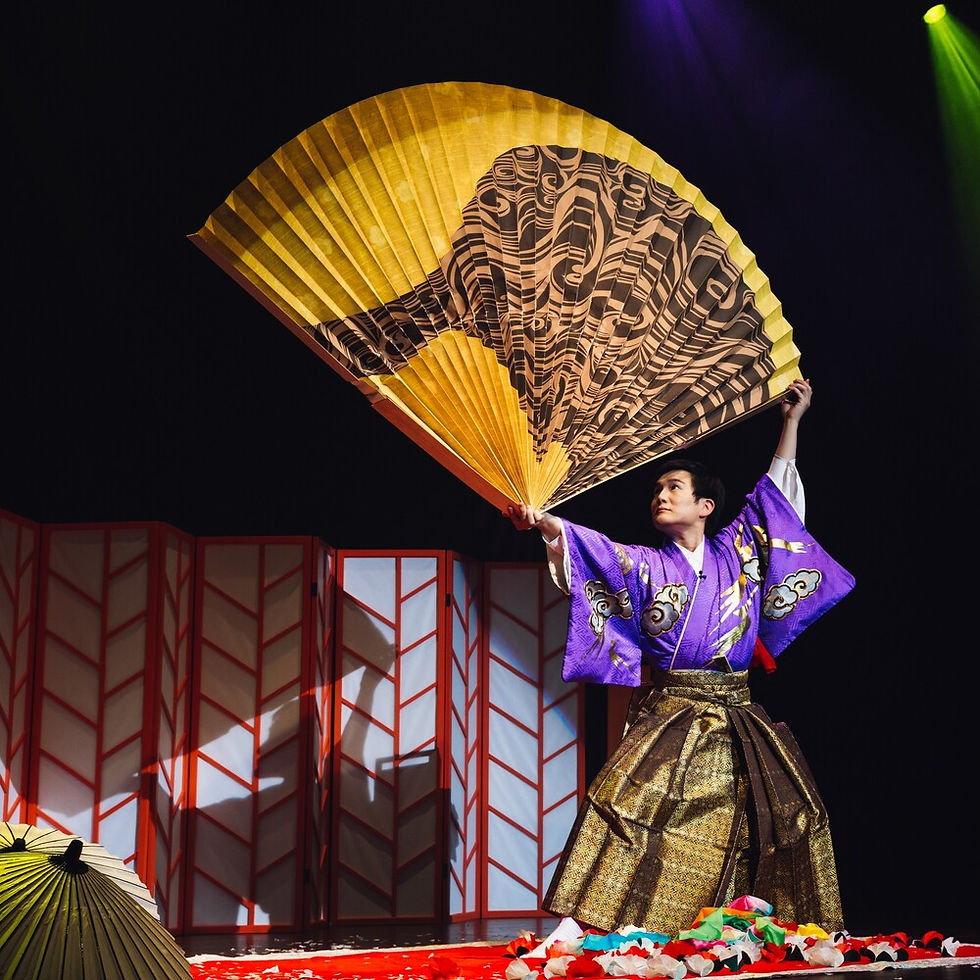The Most Interesting Things to Do in Tokyo, Japan: Revealed Through History
- 真也 山田
- 5 days ago
- 7 min read

Why are traditional cultural experiences so profoundly interesting? The proof is in their very survival over centuries.
For hundreds of years, Japan has endured countless civil wars, global conflicts, catastrophic natural disasters like volcanic eruptions and great earthquakes, and devastating famines. And yet, through it all, these traditions have survived.
Unlike food or shelter, culture is not strictly necessary for human survival. It persists for only one reason: because for hundreds of years, an unbroken chain of people—likely numbering in the millions when counted across generations—found it to be deeply "interesting" (omoshiroi).
An art form that has been chosen, supported, and passed down through centuries of hardship is, by definition, guaranteed to be interesting. It is a masterpiece vetted by time itself.
A Tale of Two Capitals: How History Forged the Cultural DNA of Kyoto and Tokyo
The principle that survival proves value is nowhere more evident than in the cultural evolution of Japan's two great capitals. To truly understand the "interesting things" Japan has to offer, one must first know the story of how these two cities forged completely different cultural souls.
Kyoto — The Cradle of Imperial Grace ("Miyabi")
As our timeline will show, the seeds of most of Japan's quintessential arts were sown in Kyoto and the surrounding Kamigata region. As the imperial capital for over a millennium—the emperors resided in Kyoto continuously from 794 until 1869—it was the exclusive domain of the emperor, court nobles, and high-ranking priests. In this rarified environment, arts like Gagaku court music, Nohgaku, and the Tea Ceremony were polished to a state of unparalleled refinement. The aesthetic that flourished here was "Miyabi"—a courtly, elegant, and deeply nuanced grace.

Tokyo (Edo) — The Crucible of Samurai Chic ("Iki")
When Shogun Tokugawa Ieyasu established his shogunate in Edo in 1603, the de facto political center of gravity shifted to modern-day Tokyo, and a new cultural crucible was formed. Fueled by the strict discipline of the ruling samurai class and the vibrant energy of its commoner population—in what was at the time the world's largest city—Edo did not simply copy Kyoto's "Miyabi" culture; it uniquely reinvented it. Here, a new aesthetic was born: "Iki"—a chic, worldly, and refreshingly direct sophistication.
The delicate, Noh-influenced dances of Kyoto evolved into the powerful and spectacular drama of Kabuki in Edo. The hand-painted scrolls of the court were replaced by the mass-produced artistry of Ukiyo-e woodblock prints, beloved by the people.
After the transition from the Edo to the Meiji period in 1868, the emperor also moved his residence to Tokyo, making it the capital of Japan in both name and reality. For over 400 years, Tokyo has been cultivating its own living culture.

A Visual Timeline: The Evolution of Japanese Culture at a Glance
The following timeline illustrates this remarkable cultural divergence. On the left, you see the arts born and refined in the imperial capital region of Kamigata; on the right, how they were transformed and popularized in the shogun's new city of Edo and modern Tokyo.
Timeline Summary
701

The Imperial Gagaku Bureau (Gagaku-ryō) is established [Kamigata (Kyoto, Nara, Osaka)]
1191

The monk Eisai introduces Zen Buddhism (Rinzai school) and tea from China [Kamigata (Kyoto, Nara, Osaka)]
1333-1443

Kan'ami and his son Zeami perfected Nohgaku under the patronage of Shogun Ashikaga Yoshimitsu [Kamigata (Kyoto, Nara, Osaka)]
1580

Sen no Rikyū perfects the Wabi-cha style of tea ceremony [Kamigata (Kyoto, Nara, Osaka)]
1587

The first Kagai (geisha district), Kamishichiken, is officially sanctioned by Toyotomi Hideyoshi in Kyoto [Kamigata (Kyoto, Nara, Osaka)]
1603

Kabuki is born, originating with the performances of Izumo no Okuni [Kamigata (Kyoto, Nara, Osaka)]
1628

Sumptuary laws are issued, forming the foundation of "Iki" (chic) culture [Edo (Tokyo)]
1670

The origins of Ukiyo-e woodblock prints emerge with Hishikawa Moronobu [Edo (Tokyo)]
1688-1704

The Nishikawa-ryū, the oldest school of Japanese dance, is founded [Edo (Tokyo)]
1798

The first Yose (storyteller theaters) are established [Edo (Tokyo)]
1887

The Tokyo University of the Arts is established [Tokyo]
A Detailed Timeline of Japanese Traditional Culture (Arts & Crafts)
Asuka Period: 592–710
5th-6th Cent.: Origins of Nishijin weaving [Kamigata (Kyoto, Nara, Osaka)]
c. 6th Cent.: Gagaku court music, Koto, and Biwa are introduced from the Asian continent [Kamigata (Kyoto, Nara, Osaka)]
672: Origins of Ise Daikagura acrobatics [Other (Ise)]
701: The Imperial Gagaku Bureau (Gagaku-ryō) is established [Kamigata (Kyoto, Nara, Osaka)]
Nara Period: 710–794
c. 8th Cent.: Sangaku (also Sarugaku) entertainment is introduced from the continent, becoming the origin of Nohgaku, Kabuki, Tezuma, Bunraku, and Daikagura [Kamigata (Kyoto, Nara, Osaka)]
c. 8th Cent.: The art of Kumihimo (braided cords) is introduced from the continent [Kamigata (Kyoto, Nara, Osaka)]
c. 8th Cent.: Gagaku is Japanized as the ceremonial music of the Imperial Court [Kamigata (Kyoto, Nara, Osaka)]
796: Origins of Amezaiku candy craft [Kamigata (Kyoto, Nara, Osaka)]
Heian Period: 794–1185
c. 839: First known records of Bonsai [Kamigata (Kyoto, Nara, Osaka)]
877: Kyo-sensu (Kyoto folding fans) are created [Kamigata (Kyoto, Nara, Osaka)]
Post-900: The Hiragana phonetic script is developed [Kamigata (Kyoto, Nara, Osaka)]
10th-11th Cent.: Letter-writing culture and literature flourish (Tale of the Bamboo Cutter, Tales of Ise, The Pillow Book, etc.) [Kamigata (Kyoto, Nara, Osaka)]
Early 900s: Mochi (rice cakes), Japan's oldest processed food, is created [Kamigata (Kyoto, Nara, Osaka)]
10th-12th Cent.: Dengaku (ritual rice-planting music and dance) develops [Other Regions]
c. 1183: Tofu is introduced to Japan [Kamigata (Kyoto, Nara, Osaka)]
Kamakura Period: 1185–1333
1191: The monk Eisai introduces Zen Buddhism (Rinzai school) and tea from China [Kamigata (Kyoto, Nara, Osaka)]
1227: The monk Dōgen introduces the Sōtō school of Zen [Other (Echizen, etc.)]
13th Cent.: Along with the tea ceremony, Wagashi (Japanese confectionery) culture develops [Kamigata (Kyoto, Nara, Osaka)]
Muromachi Period: 1336–1573
1333-1443: Kan'ami and his son Zeami perfect Nohgaku theatre under the patronage of Shogun Ashikaga Yoshimitsu [Kamigata (Kyoto, Nara, Osaka)]
c. 1449-73: The art of Kintsugi (golden joinery for pottery) originates during the era of Shogun Ashikaga Yoshimasa [Kamigata (Kyoto, Nara, Osaka)]
c. 1580: Sen no Rikyū perfects the Wabi-cha style of tea ceremony [Kamigata (Kyoto, Nara, Osaka)]
c. 15th-16th Cent.: The origins of Edo Komon begin with fine-patterned dyeing for samurai garments [Kamigata (Kyoto, Nara, Osaka)]
Azuchi-Momoyama Period: 1573–1603
Late 16th Cent.: Nohgaku flourishes further under the patronage of Toyotomi Hideyoshi [Kamigata (Kyoto, Nara, Osaka)]
c. 1560: The Shamisen instrument is introduced from the Ryukyu Kingdom to Sakai (near Osaka) [Kamigata (Kyoto, Nara, Osaka)]
Late 16th Cent.: The "Three Schools of Gagaku" are established (Imperial Court, Nara, and Tennoji Temple) [Kamigata (Kyoto, Nara, Osaka)]
c. 1580: The first Hōkan (male geisha) appear as entertainers for Toyotomi Hideyoshi [Kamigata (Kyoto, Nara, Osaka)]
1587: The first Kagai (geisha district), Kamishichiken, is officially sanctioned by Toyotomi Hideyoshi in Kyoto [Kamigata (Kyoto, Nara, Osaka)]
Edo Period: 1603–1867
1603: Kabuki is born, originating with the performances of Izumo no Okuni [Kamigata (Kyoto, Nara, Osaka)]
Early 17th Cent.: Bunraku puppet theatre is born [Kamigata (Kyoto, Nara, Osaka)]
1628: Sumptuary laws are issued, forming the foundation of "Iki" (chic) culture [Edo (Tokyo)]
Early 17th Cent.: Edo Komon dyeing becomes the origin of "Iki" culture, used for samurai kamishimo garments [Edo (Tokyo)]
Early 17th Cent.: The Edo shogunate protects Nohgaku as official "ceremonial music" [Edo (Tokyo)]
1642: A Gagaku ensemble is established at Edo Castle [Edo (Tokyo)]
Post-1670: The origins of Ukiyo-e woodblock prints emerge with Hishikawa Moronobu [Edo (Tokyo)]
c. 1680: Kyo-Yuzen dyeing is established [Kamigata (Kyoto, Nara, Osaka)]
1680: The Mugai-ryū school of swordsmanship is founded [Edo (Tokyo)]
1688-1704: The Nishikawa-ryū, the oldest school of Japanese dance, is founded [Edo (Tokyo)]
1695: The Ikuta-ryū school of Koto music is founded [Kamigata (Kyoto, Nara, Osaka)]
Late 17th Cent.: Kabuki develops its own regional styles: wagoto (soft style) in Kamigata and aragoto (rough style) in Edo [Kamigata / Edo]
c. 1700: The iconic "Tatsumi Geisha" flourish in the Fukagawa district, symbolizing "Iki" culture [Edo (Tokyo)]
c. 1700: Kaga-Yuzen dyeing is established [Other (Kanazawa)]
1704-10: The Fujima-ryū school of Japanese dance is founded [Edo (Tokyo)]
18th Cent.: Wagashi culture blossoms with Kyoto's Kyo-gashi and Edo's Jo-gashi [Kamigata / Edo]
Mid-Edo Period: Edo-furin (glass wind chimes) are created [Edo (Tokyo)]
1733: The Sumidagawa Fireworks festival begins [Edo (Tokyo)]
c. 1781-1801: The Yamada-ryū school of Koto music is founded [Edo (Tokyo)]
1782: The "One Hundred Delicacies of Tofu" cookbook is published in Osaka [Kamigata (Kyoto, Nara, Osaka)]
1797: The Inoue-ryū of Kyo-mai (Kyoto dance) is founded [Kamigata (Kyoto, Nara, Osaka)]
1798: The first Yose (storyteller theaters) are established [Edo (Tokyo)]
1804-30: The Bandō-ryū school of Japanese dance is founded [Edo (Tokyo)]
Post-1800: As pilgrimage travel booms, Daikagura performers distribute talismans from shrines like Ise Grand Shrine [Edo (Tokyo)]
Post-1800: Landscape Ukiyo-e by masters like Katsushika Hokusai and Utagawa Hiroshige become immensely popular [Edo (Tokyo)]
1834: Edo-kiriko cut glass is created [Edo (Tokyo)]
Mid-19th Cent.: The Yose theater boom leads to the popularization of Daikagura, Rakugo, and Tezuma [Edo (Tokyo)]
1849: The Hanayagi-ryū, the largest school of Japanese dance, is founded [Edo (Tokyo)]
Meiji Period: 1868–1912
1870: The Imperial Household Agency Music Department is established, protecting Gagaku [Tokyo]
1870: The Rickshaw is invented [Tokyo]
Late 19th Cent.: The term "Sarugaku" is officially renamed "Nohgaku" [Tokyo]
1887: The Tokyo University of the Arts is established [Tokyo]
Late 19th Cent.: Kabuki incorporates Noh plays into its repertoire, further developing as a theatrical art [Tokyo]
1893: The Wakayagi-ryū school of Japanese dance is founded [Tokyo]
Taisho Period: 1912–1926
(No major new developments)
Showa Period: 1926–1989
1970: Rickshaws for sightseeing appear in Hida-Takayama [Other (Hida-Takayama)]

Experience Living History: A Guide to Our Curated Encounters
This grand history is not confined to museums. It is a living, breathing tradition that you can encounter today, directly from the masters who are its custodians. Understanding this history is the key to unlocking a truly interesting experience.
Here is how you can encounter these living traditions through our curated programs, each linked to its deep historical roots:
A festive art with sacred origins dating back to 672

The world's oldest orchestral music, formally established in 701

An Edo-period spectacle with roots in magic introduced in the 8th Century

An intricate craft with techniques introduced to Japan in the 8th Century

An aesthetic culture that blossomed alongside Zen Buddhism from the 12th Century

The spiritual art of the samurai, perfected in the 1300s

The chic dyeing style of the samurai, with origins in the 15th-16th Centuries

The ultimate in exclusivity, with roots in the 1580s

A tradition of refined hospitality originated in Kyoto (1587)

The iconic art of the Edo period, which emerged in the 1670s

Conclusion: Curating the Most Interesting Things to Do in Tokyo, Japan
Understanding this history transforms a simple activity into a deep cultural dialogue. We believe the ultimate proof of value lies in an art form's very survival through centuries of hardship—a masterpiece vetted by time itself.
This historical perspective is the key to discovering the truly interesting things to do in Tokyo, Japan.
At Kagurazaka Refined Wander, we are not just guides; we are historical storytellers who curate profound encounters with these living masterpieces. We are your partners in accessing the very soul of Japanese culture, a soul that was forged in the graceful courts of Kyoto and reforged in the dynamic streets of Tokyo.



Comments